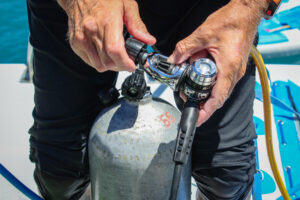What is a Lift Bag?
A lift bag is an essential piece of equipment in scuba diving, designed to assist divers in lifting heavy objects from the underwater environment to the surface. These devices use the principle of buoyancy to generate upward force, making it possible to transport items that would otherwise be too cumbersome or heavy to handle manually. Lift bags are commonly employed in various underwater tasks, from salvage operations and marine construction to scientific research. They play a crucial role in ensuring the safety and efficiency of these activities, providing divers with a reliable means to manage and move objects underwater.
History and Development of Lift Bags
The concept of using buoyancy to lift objects from underwater dates back to ancient times when simple air-filled containers were used for basic lifting tasks. Over the centuries, this rudimentary idea evolved significantly. Early innovations included the use of barrels and other buoyant objects that could trap air and provide lift. However, these early devices were often unreliable and difficult to control.
The modern lift bag, as we know it, began to take shape in the mid-20th century. Advances in materials science and engineering led to the development of more sophisticated and durable lift bags. The introduction of synthetic fabrics, such as nylon and neoprene, allowed for the creation of lift bags that were both strong and flexible. These materials could withstand the pressures of deep-sea environments and the rigors of underwater operations.
Significant technological advancements continued into the late 20th and early 21st centuries. Modern lift bags are now equipped with safety features such as overpressure valves, which prevent the bags from bursting due to excessive internal pressure. Additionally, the development of more precise control mechanisms has made it easier for divers to manage the ascent of heavy objects, reducing the risk of accidents. The continuous evolution of lift bag technology has made them indispensable tools in a wide range of underwater applications.
Types of Lift Bags
Lift bags come in various types, each designed to meet specific needs and conditions. The most common types include open bottom, enclosed, and parachute-style lift bags, each with its unique characteristics and applications.
Open bottom lift bags are among the most widely used. These bags have an open bottom design that allows air to escape gradually as the bag ascends. This feature helps maintain stability and control during the lifting process. Open bottom lift bags are often used for lifting relatively lightweight objects or in shallow water operations where precise control over the ascent is less critical.
Enclosed lift bags, also known as closed lift bags, are designed to trap air within a sealed chamber. These bags provide a more controlled and stable lift, making them ideal for lifting heavier objects or in situations where precise control is essential. Enclosed lift bags are often used in salvage operations, where the stability of the lift is crucial to prevent damage to the object being lifted or to the surrounding environment.
Parachute-style lift bags are designed for lifting very heavy objects from significant depths. These bags have a conical shape that allows for a rapid ascent once inflated. The parachute design ensures that the lift bag maintains its stability and orientation during the ascent. This type of lift bag is commonly used in deep-sea salvage operations and other demanding underwater tasks where significant lifting power is required.
Each type of lift bag is designed to perform optimally under specific conditions, and divers must select the appropriate type based on the requirements of their particular operation. Understanding the differences between these types and their respective applications is crucial for the safe and effective use of lift bags in underwater activities.
Physics and Mechanics of Lift Bags
The operation of lift bags is grounded in the principles of buoyancy and displacement. Buoyancy is the upward force exerted by a fluid on an object placed in it, which in the case of lift bags, is the force exerted by water on the air-filled bag. This upward force is what allows the lift bag to raise heavy objects from the seabed to the surface.
When a lift bag is deployed, it is filled with air, usually from a diver’s tank or an independent air source. As the bag fills, it displaces an equivalent volume of water, creating an upward force. The amount of lift generated depends on the volume of air inside the bag and the density of the water. For example, in saltwater, which is denser than freshwater, a given volume of air will provide more lift.
To achieve neutral buoyancy, where the lift bag and the object it is lifting neither sink nor float uncontrollably, precise calculations are necessary. Divers must determine the weight of the object in water, accounting for the fact that objects underwater weigh less than they do on land due to the buoyant force. This weight is known as the object’s apparent weight. The lift bag must then be filled with enough air to counteract this apparent weight, achieving a state where the combined system is neutrally buoyant.
Properly managing the ascent of a lift bag is critical to avoid rapid, uncontrolled rises that can be dangerous. Most lift bags are equipped with dump valves that allow divers to release air gradually, controlling the rate of ascent. This careful management ensures that the object reaches the surface safely and without causing harm to the divers or the equipment.
Operational Guidelines
The successful and safe use of lift bags requires adherence to a set of operational guidelines. These guidelines encompass pre-dive checks, deployment procedures, and safety measures to ensure the effective lifting of objects from underwater environments.
Before deploying a lift bag, divers must conduct thorough pre-dive checks. This includes inspecting the lift bag for any signs of damage, ensuring that all valves and seams are intact, and verifying that the inflation system is functioning correctly. Additionally, divers should assess the weight and condition of the object to be lifted, determining the appropriate type and size of the lift bag needed for the operation.
When attaching the lift bag to the object, secure and reliable attachment points must be used. Common methods include using lifting straps, shackles, or nets designed to distribute the weight evenly and prevent slippage. Once the lift bag is securely attached, the diver begins inflating it with air. It is crucial to monitor the inflation process closely, ensuring that the bag does not overinflate and that the object remains stable.
During the ascent, divers must maintain control over the lift bag’s buoyancy. This is achieved by using the dump valves to release air as needed, preventing a rapid rise to the surface. Communication between team members is vital throughout the process to coordinate movements and address any issues that may arise. Divers should also be aware of their surroundings, avoiding any obstacles that could interfere with the lift or pose a hazard.
Safety precautions are paramount when using lift bags. Divers should always work in teams and have a clear plan in place for dealing with emergencies. It is essential to remain vigilant for any signs of equipment failure or instability in the lift. By adhering to these guidelines, divers can ensure the safe and effective use of lift bags in their underwater operations.
Applications in Scuba Diving and Underwater Work
Lift bags play a versatile and vital role in a wide range of scuba diving and underwater activities. Their applications span from recreational diving to complex commercial and scientific operations, demonstrating their importance in diverse underwater environments.
In recreational diving, lift bags are often used for lifting and retrieving objects from the seabed. This can include lost equipment, marine artifacts, or even large marine life specimens that need to be relocated. The use of lift bags in these scenarios enhances the diver’s ability to safely and efficiently manage underwater tasks, making the experience more enjoyable and productive.
Commercial diving operations rely heavily on lift bags for a variety of tasks. In the construction of underwater structures, such as pipelines, cables, and offshore platforms, lift bags are used to position and stabilize heavy components. Salvage operations, which involve the recovery of sunken vessels, aircraft, and other valuable items, also depend on the lifting power of lift bags. These operations require precise control and significant lifting capacity, both of which are provided by specialized lift bags.
Scientific research conducted in marine environments often necessitates the use of lift bags. Researchers may need to collect large samples of marine organisms, geological specimens, or archaeological artifacts from the ocean floor. Lift bags enable the safe transport of these items to the surface without causing damage. Additionally, in underwater habitat construction and maintenance, lift bags facilitate the movement of building materials and equipment.
Several case studies highlight the critical role of lift bags in underwater operations. For example, in the recovery of historical shipwrecks, lift bags have been used to carefully raise delicate artifacts to the surface, preserving their integrity for study and display. In another instance, lift bags were employed in the removal of a large debris field from a coral reef, helping to restore the natural habitat and promote marine conservation.
These applications underscore the importance of lift bags in enhancing the capabilities of divers and underwater workers. By providing a reliable means to lift and transport heavy objects, lift bags contribute significantly to the success and safety of various underwater endeavors.
Maintenance and Care
Proper maintenance and care of lift bags are essential to ensure their longevity and safe operation. Regular inspection and upkeep help prevent equipment failure and extend the life of the lift bag.
Routine maintenance involves checking the lift bag for any signs of wear and tear, such as abrasions, punctures, or seam separations. Valves and inflation systems should be inspected to ensure they are functioning correctly and not leaking. It is also important to clean the lift bag after each use, removing any salt, sand, or other debris that could cause damage over time.
When not in use, lift bags should be stored in a cool, dry place away from direct sunlight and chemicals. Proper storage helps prevent the degradation of materials and maintains the lift bag’s structural integrity. It is advisable to keep the lift bag loosely rolled or folded to avoid creases and stress points that could weaken the fabric.
In the event of minor damage, lift bags can often be repaired using patch kits designed for the specific material of the bag. These kits typically include adhesive patches that can be applied to cover small punctures or tears. For more significant damage, professional repair services may be necessary to ensure the bag is safe to use.
By adhering to these maintenance and care practices, divers can ensure that their lift bags remain reliable and effective tools for underwater operations. Regular upkeep not only enhances the performance of the lift bag but also contributes to the safety of the divers who rely on them.
Key Takeaways
Lift bags are indispensable tools in scuba diving and underwater work, providing the buoyant force necessary to lift and transport heavy objects safely. From their historical development to modern innovations, lift bags have evolved to meet the diverse needs of underwater operations. Understanding the types, mechanics, and proper use of lift bags is crucial for their effective application. By following operational guidelines and maintaining the equipment properly, divers can ensure the safety and efficiency of their underwater activities.
















